
|
Astronomy Picture Of the Day (APOD)
 A Leonid Bolide Over Kansas
A Leonid Bolide Over Kansas
25.11.1998
The 1998 Leonid Meteor Shower featured many bright events. Extremely bright meteors, known as bolides or fireballs, can briefly glow brighter than the full moon. Pictured above is a Leonid bolide caught during a five-minute, wide-angle exposure. The bolide was so bright it lit up the surrounding area, making otherwise dark trees visible.
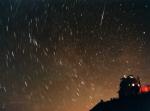 Seven Leonids Over Wise Observatory
Seven Leonids Over Wise Observatory
24.11.1998
More Leonids were visible at some places than others. In Israel, early in the morning of 17 November, it rained meteors though a clear sky. Observers there reported a peak rate for the 1998 Leonid Meteor Shower of about 600 meteors per hour.
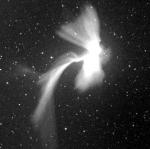 A Leonid Meteor Explodes
A Leonid Meteor Explodes
23.11.1998
Click on the above image and watch a Leonid meteor explode. The tremendous heat generated by the collision of a small sand-bit moving at 70 kilometers/second with the Earth's upper atmosphere causes the rock-fragment to heat up, glow brightly, and disintegrate.
 The High Energy Crab Nebula
The High Energy Crab Nebula
22.11.1998
This is the mess that is left when a star explodes. The Crab Nebula is so energetic that it glows in every kind of light known. Shown above are images of the Crab Nebula from visible light to the X-ray band.
 Catching Falling Stardust
Catching Falling Stardust
21.11.1998
This carrot shaped track is actually little more than 5 hundredths of an inch long. It is the trail of a meteroid through the high-tech substance aerogel exposed to space by the shuttle launched EURECA (European Recoverable Carrier) spacecraft.
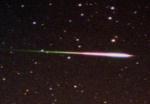 Green Fireball
Green Fireball
20.11.1998
"Goodness, Gracious, Green Balls Of Fire!", might have been an appropriate theme song title for the 1998 Leonid meteor shower. Many observers, like astrophotographer Steve Dunn watching from Cape Canaveral, Florida, USA, reported that a lot of the characteristically bright Leonid meteors had a greenish tint.
 Bright Leonids
Bright Leonids
19.11.1998
Rich in bright and awesome fireballs, the Leonid Meteor Shower came early this year. In fact, judging from meteor watcher reports the peak came nearly 15 hours earlier than the best predictions. Observers...
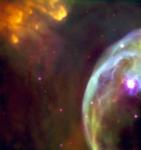 Close Up of the Bubble Nebula
Close Up of the Bubble Nebula
18.11.1998
It's the bubble versus the cloud. NGC 7635, the Bubble Nebula, is being pushed out by the stellar wind of massive central star BD+602522. Next door, though, lives a giant molecular cloud, visible above to the upper left.
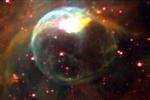 NGC 7635: The Bubble Nebula
NGC 7635: The Bubble Nebula
17.11.1998
What created this huge space bubble? A massive star that is not only bright and blue, but also emitting a fast stellar wind of ionized gas. The Bubble Nebula is actually the smallest...
 Leonids 1998: A Safe Meteor Storm
Leonids 1998: A Safe Meteor Storm
16.11.1998
You're in no danger. During the meteor storm occurring tonight and tomorrow, thousands of bits of ice and rock will likely rain onto the Earth. Few, if any, will hit the ground. Touted as potentially the most active meteor shower since 1966, the Leonids of 1998 will be tracked by observers the world over.
|
January February March April May June July August September October November December |
|||||||||||||||||||||||||||||||||||||||||||||||||